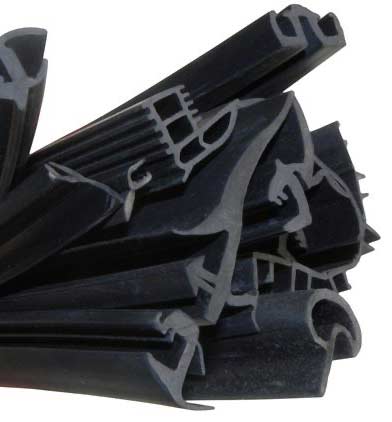Seal Material Selection
Determining the right material for your application is critical for long-term performance of your edge trim or seal. Poor material choice may lead to poor performance or shortened lifespan. So, what are the factors to consider when deciding on material for your seal or edge trim? Here are some questions to ask when selecting materials:
- Will there be exposure to water, oils, gases or other chemicals?
- What are the minimum and maximum operating temperatures?
- Will it be exposed to sunlight for extended periods of time?
- What is the hardness and compression set that is required? (compression set is the ability of rubber to return to its original size after being compressed for a long period of time).
In addition to the above factors, you will need to consider the cost of the compound as this will vary wildly. Unique compounds rather than a typical rubber or plastic compound are more expensive and require a higher minimum order quantity. These compounds are only used when a common compound cannot do the job—often due to high heat or exposure to corrosive material. We will help you make the most cost effective choice.
Here is a quick summary outlining some of the differences in some common elastomers.

EPDM
EPDM is our most commonly extruded elastomer for rubber seals. It is a very good compound for use in outdoor applications as it is very resistant to weathering and ozone exposure (A quick note on ozone exposure: Ozone is found in the air in small quantities but creates an aging effect on elastomers that looks like cracking or dry rot. This reduces the performance of the material and after time will require the replacement of the seal). EPDM is not recommended where the medium it will operate in will have exposure to oils and gas, but it is water resistant and maintains its flexibility in low temperatures. In general EPDM will operate well in a temperature range of -80°F to 300°F.
Silicone
Like EPDM, silicone is very resilient against the effects of ozone and UV light. If your application is going to expose it to gas, oil or acids or if it needs to have strong tensile strength it probably wouldn’t be the material of choice. Silicone is a more expensive elastomer than EPDM, but it has some benefits over EPDM that make it the material of choice for some applications. The key benefit that silicone has over EPDM is tolerance to cold and heat. Silicone can operate under conditions from -180°F to 525°F. This ability to withstand high heat makes silicone ideal for uses like sealing autoclaves. Silicone is an expensive option, but critical for extreme heat environments.
Neoprene
Neoprene is resistant to oils, ozone, and water amongst other things. Unlike silicone it resists cracking and abrasions when under stress or impact. Its operating range within cold and hot temperatures is similar to rubber, -80°F to 300°F. Neoprene is used in windows, electrical enclosures, expansion joints and lots of other applications. Neoprene costs a bit more than EPDM but won’t break the bank like a silicone compound.
Nitrile
Nitrile is in the middle of the road from a cost standpoint. It’s a great choice for applications such as oil seals, aircraft hoses, or anywhere resistance to oil, fuel and chemicals is important. Its optimal operating temperature range is from -55°F to 275°F, so not the best choice for extreme temperature ranges. Nitrile doesn’t do well resisting the aging effects of sunlight or exposure to the elements but can be compounded in order to increase its resistance to these effects.
PVC
PVC has a limited temperature rating of -20°F to 158°F. PVC is a thermoplastic, which means that it is cured when it cools down. This is very different from the other elastomers in this article, which are thermosets...meaning they cure when heated up. So if PVC gets too hot it can become deformed. PVC can fade in sunlight, but Uni-Grip’s PVC has an additive to reduce the effects of fading, making it a good choice for outdoor conditions. If there will be exposure to oil or gas, then you may want to choose a different material as PVC doesn’t resist these materials well.
Selecting the Right Seal for Your Application
When choosing seals, you should consider several factors, including the type of seal, its application, seal material, hardness, and attachment. We manufacture a wide range of seals, including:
- Bulb seals: Used to seal doors with hollow circular seals
- Flap seals: Incorporates a wiper blade to exclude moisture
- Trim seals: Seals against the elements using a rubber bulb attached to a firm plastic edge trim
- Lid seals: Protects against moisture and dirt
- Slide-out seals: Prevents ingress of moisture, dirt and dust on RV slide-out rooms
- Accordion seals: Seals gaps between a camper shell and a truck
We supply a range of seal materials for different environments. Materials may withstand exposure to cold and hot water, fuels, hydraulic fluids, or extreme ambient temperatures. Choices include EPDM synthetic rubbers, nitrile rubber, silicone, and PVC. Many of the seals incorporate a metallic core to increase strength and rigidity. Sponge rubber is used for door seals, while dense rubber has better impact absorption properties. Some seals have a dual durometer with a more rigid mounting material and a less dense seal. Attachment options include flange mounting, pedestal mount, and adhesive mounts.
Use our Sealfinder to select the right profile and seal material. Alternatively, contact us for custom applications.
